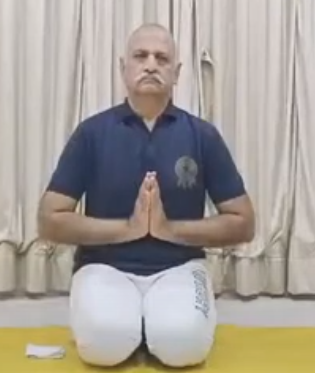When we listen about Mudra word, we normally think about currency. In the ancient time, when coins were invented for the purpose of exchange, they were called Mudras.
In the Indian tradition every word has its meaning and description about its soul. Although a word is only a direction, but it also explains very close meaning of it. In the Sadhana Therapy, Mudra word is being used for some specific posture or position. Every expression and position of our body is also called Mudra. Different positions of our body give us hint to understand different feelings. It is our shortcoming that we can't understand all the feelings. That's why, the distinct shape that appears on our body are normally being called Mudras. In fact, the internal feelings in our body, itself leads to different and distinct posture of our body. "Yatha Brahmande Tatha Pinde" it means what is present in the universe is also present in our body. The meaning of Pind is that our body is created by five elements. Reading and hearing about this is a bit surprising. Every person is attracted to the beautiful things. But the question arises why? Why do we like to see beautiful things and beautiful faces? Why do we want to attain them? Because we also have abundant beauty inside our body and if we are unable to see beautiful things, we feel a kind of incompleteness, a kind of thirstiness and a sense of loneliness. This is the reason we are constantly attracted to the outside beauty. It is really unfortunate that we are unable to see our inner beauty and we search for it outside.
Saint Kabirdasji has quoted:- "Sadho Hari bin Jag Andhiyaara, Ya Ghat Bheetar Sona Chandi, Ya Hi Me Laagat Bazaara."
- "Ya Ghat Bheetar Heera Moti, Ya Hi Me Parkhan Hara, Ya Ghat Bheetar Kashi Mathura, Ya Hi Me Gadh Girnara."
- "Ya Ghat Bheetar Ram Biraje, Ya Hi Me Thakur Dwara, Ya Ghat Bhitar Teen Lok Hain, Ya Hi Me Sirjan Hara."
- "Kahe Kabir Sun Bhai Santo, Ise me Sai Hamaara"
It means we are unable to discover our inner happiness that we are searching in the outside world. That's why instead of remaining happy in our life, we are lost in the deep darkness. Our inner feelings itself leads to various postures in our body. Inner and outer part of our body is so well connected with each other that every action which takes place outside has a direct impact on the inner side and similarly every feeling that is inside results to develop a posture outside. Whatever we feel inside, it immediately affects our body and vice-versa. Whatever we feel in our body, it directly affects our inner thoughts and behavior. This is the reason there is a change in our posture every second. This change takes place so quickly that it cannot be captured even by a fast rolling movie camera. It can capture only when this change converts into still posture.
Posture with full of expressions of body is called Mudra. It has already been explained that there is a deep relation between Mudras and feelings. To avoid further explanation on this topic, I would like to say in short that Mudra is directly created as per our feelings. Similarly, whatever posture we adopt it directly reflects our feelings. Every person's nature depends on how he thinks inside. Similarly, every person's nature reflects his behavior directly. A person is bound to get similar behavior from the other person as he behaves with him. This is the reason, why we should adopt right postures in our daily life, as this will results in the balancing of the expressions and the feelings. Right postures help to increases alertness and person remains healthy. It also helps in development of intelligence and good feelings. We should not adopt wrong postures as it results in development of bad expressions, which in turn creates bad feelings. Wrong posture increases laziness in the mankind, person tend to become unhealthy. It adversely affects his intelligence and also develops bad nature.
In this book of 'The Science of Mudras' the posture of Mudras are depicted clearly and also talks about the after effect after one practice them regularly.
 Parasmal Duggad
Parasmal Duggad
